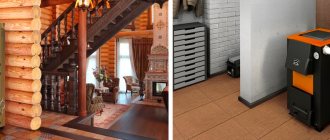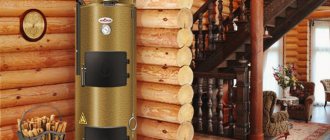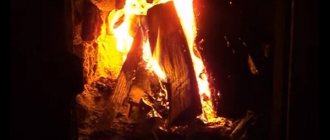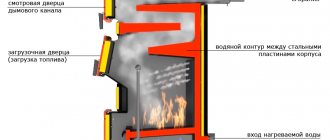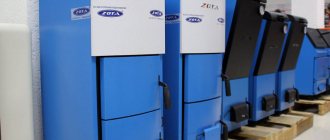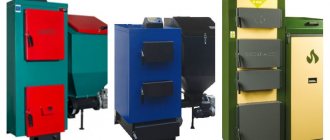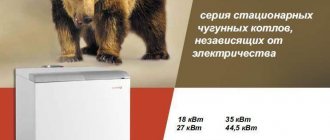Peat is a combustible mineral that is used as an environmentally friendly fuel. It can operate both domestic home boilers and large power plants and industrial boiler houses.
From this article you will learn:
- How effective is peat in terms of heating?
- How to choose the right peat
- What are the advantages and disadvantages of peat compared to other materials?
- How to heat a boiler with peat
- Where and how to store peat
- What are the environmental aspects of using peat as fuel?
This information will be useful if you:
- Are you planning to buy a boiler and are considering peat as one of the fuel options?
- If you are not satisfied with the material that is currently used to heat your house, and you want to switch to peat
- If you have peat on your site and want to know if it can be used for heating
Design Features
Peat is a cheap and renewable solid fuel. It is clear why boiler houses operating on coal are now increasingly being converted to peat briquettes. Although, theoretically, nothing prevents the owner from using this type of fuel in a classic unit, in practice everything turns out to be somewhat more complicated than it seems.
Construction of a solid fuel boiler KLIVER-25P
There are the following nuances to this:
- Peat in a standard wood or coal boiler burns with an even blue flame and produces a lot of heat. However, during the combustion process, soot remains on the surface of the fuel, which prevents oxygen from entering. Peat burns longer, but heat transfer becomes significantly lower.
- The ash residue is characterized by high density, because of this, combustion products, when burned, do not fall through the grate into a special niche for ash, but accumulate on the grate, and thereby impede air circulation.
- Peat has relatively high humidity. This drawback must be addressed by heating equipment manufacturers. In nature, peat has a moisture content of about 85-90%. After drying, the percentage is 30-60% (depending on the variety).
You can read more about the properties of peat and peat briquettes in this article.
In a solid fuel boiler, you can use peat briquettes, which are made from small particles of raw materials by pressing. After processing, peat has other indicators: lower humidity and ash content. This makes it possible to use peat briquettes in classic units.
You can read more about the operation of pyrolysis boilers in this article.
Classification of combined equipment
There are several types of pellet-wood boilers. They can be classified according to several criteria.
By burner type
There are 3 types of devices for burning pellets:
- flare;
- volumetric;
- fireplace
The former have the following advantages:
- simple design;
- reliability;
- compactness;
- undemanding to fuel quality.
Flaws:
- limited power;
- horizontally directed flame, which causes uneven heating of the boiler.
Pellet-wood boilers differ in the type of burner.
Advantages of a volumetric burner:
- unlimited power;
- higher efficiency than flare.
Flaws:
- complex device;
- big size;
- high requirements for the quality of granules;
- dependence on the angle of inclination (as the amount of slag increases, the amount of slag increases until the feeding mechanism stops);
- long auger (generates wood dust, which negatively affects the operation of the device).
The fireplace burner allows you to admire the flames. It is equipped with a bowl into which pellets are dumped. Air is supplied to the combustion zone from below.
Such models have low efficiency; if there are no special requirements for aesthetics, it is better to choose flare or volumetric.
According to heat exchanger material
Boiler tanks are:
- steel;
- cast iron
Boiler tanks are made of steel.
The advantages of the former include:
- low cost;
- light weight;
- maintainability;
- plastic.
Disadvantages are susceptibility to corrosion and the presence of welded seams in the structure, which limits the service life to 12-14 years.
Cast iron heat exchangers are durable and do not rust, so they work for more than 25 years. But they:
- expensive;
- heavy;
- fragile - when exposed to cold water and impacts, they can crack;
- cannot be restored.
By download method
In different models, the granule feeding speed is adjusted by 2 methods:
- automatically;
- manually.
In most models, the supply of granules is manually adjusted.
The second method is inconvenient, because... the user has to independently monitor the temperature of the coolant.
By number of circuits
A simple boiler is equipped with 1 heat exchanger connected to the heating system. Such units are called 1-circuit.
There are models that additionally perform the function of a water heater. They are called 2-circuit and can be equipped with:
- secondary heat exchanger;
- boiler.
In the first case, flow heating is carried out. When the user opens a hot water tap, the 3-way valve shuts off the heating system and the working fluid begins to circulate through the secondary heat exchanger. With high consumption of hot water, the batteries do not receive enough heat.
A boiler with a boiler is more practical. It has the following advantages:
- heats water only at those moments when the heating circuit does not need heat;
- DHW performance is always high and does not depend on power.
The disadvantages of such installations are their large size and energy losses to maintain the temperature in the storage device.
Peat boiler for home
A household solid fuel boiler that heats water by burning peat briquettes is designed in such a way as to ensure the best performance and calorific value, taking into account the specifics of fuel combustion. The unit operates in stages:
- Peat is fed into the furnace using a screw conveyor. Before this, the fuel is crushed using special equipment so that the fractions do not get stuck in the transmission.
- There is no standard horizontal grate; here it is installed at an angle.
- For the best thermal efficiency, the peat entering the grate is initially dried with warm air, which is heated in the afterburner.
- Small volatile peat particles ignite and thereby quickly heat the combustion chamber to the required temperature.
- The fuel ignites and burns in an intense combustion mode.
- In household models, a pyrolysis process occurs during intense combustion. Carbon dioxide, which is released during the combustion of peat, is afterburned in a special chamber. This makes it possible to obtain more heat energy.
If you plan to use peat as the main type of fuel, then it is advisable to buy a universal boiler that runs on peat, wood, briquettes, or convert a coal boiler.
The following models of heating units presented in the table are considered the most popular.
| Domestic production | Termofor, Retra, Lavoro (joint production of Italy and Russia) |
| Import production | Czech Dakon, Japanese Kentatsu, Lithuanian Aremikas Candle, Ukrainian Palche and ATON, Polish Galmet and SAS |
Almost all of the above manufacturers, in addition to household heating boilers, also produce industrial boilers that operate on peat briquettes and sod peat.
Construction of the Kholmov pyrolysis boiler.
Kindling the bath
Eurobriquettes are a universal fuel; they can be used to heat all types of stoves and boilers. They can be used in outdoor grills and home fireplaces. At the same time, the consumption of fuel briquettes is always significantly less than conventional firewood.
Many people are interested in whether it is possible to heat a stove with fuel briquettes if it is made of steel, like an ordinary heater? This question is quite logical, since such stoves have restrictions on the calorific value of the fuel; you cannot heat a steel sauna stove with black coal, which emits 4900 kcal/kg of heat. But in the case of Eurobriquettes, less heat is released, which means they can be used to heat a stove in a bathhouse.
For a bathhouse, not only the heat generated is important, but also the duration of burning of wood or alternative fuel. The longer the wood burns with maximum heat release, the better it is for the sauna stove and the sauna itself.
Lighting fuel briquettes is not very easy, the fire does not catch immediately, but after they light up, they will burn and smolder for a couple of hours, which is much longer than the combustion of ordinary firewood. Such a long combustion time of fuel briquettes is explained by their high density and low humidity.
The large amount of heat generated and the long burnout time indicate that the consumption of fuel briquettes for heating a house is much less than that required for ordinary firewood.
Let us note that, according to people’s reviews, you should not completely fill the firebox of a sauna stove with Euro-wood, so as not to quickly reach the maximum heat transfer values.
An interesting point with Eurobriquettes is the residues left after their combustion. Having increased density characteristics, this fuel burns almost completely; it does not leave a large amount of ash, only a small pile of ash. Ash from fuel blocks smells unpleasant, but is an excellent fertilizer.
When Eurobriquettes burn, virtually no smoke is emitted, which is very valuable for maintaining the cleanliness of fireboxes, boilers, and chimneys. According to experts, linden fuel briquettes contain the least amount of resin, so when using such fuel, chimneys and boiler nozzles suffer the least.
Industrial models
An industrial boiler operating on peat briquettes is characterized by greater productivity and a higher level of automation of combustion processes. Close attention is paid to operational safety. Typically, industrial-type boilers have multi-level protection against overheating and unexpected fire.
solid fuel boiler Proton KVu-1.5AMT with automatic loading
The differences between these units are as follows:
- New solid fuel industrial boilers are being launched onto the market with built-in automation for fuel loading.
- The firebox is connected to a belt or screw conveyor. Peat is supplied from mechanized niches, often undergoing initial preparation in automatic mode.
- Now regarding the ash removal system. Domestic long-burning peat boilers have a grate with special holes for cleaning. A brush in the form of a hook is inserted into the firebox through these holes and the ash residues are manually removed. Industrial boilers using peat have a self-cleaning system and movable grates. When the fuel burns, the grates turn from time to time and thereby throw soot down into the ash pan. Plus, there is a function of a pneumatic self-cleaning system.
- The heat exchanger here is a niche through which there are many tubes with a coolant moving through them. A two-way as well as a three-way heat accumulation system for smoke gases is used. There are industrial boilers that function both to heat the coolant and to produce steam.
Nowadays, you can increasingly find automation of boiler feeding and cleaning in household models.
What types of briquettes are there for heating?
Let's try to understand the types of briquettes on the market; they differ from each other in shape and the material from which they are made.
Wood briquettes
Briquettes made from wood, or as they are also called Euro firewood. These include Ruf, Nestro, Pini-Kay, they differ in density and manufacturing method, and there is also a difference in appearance. They are made from wood waste, the moisture content of the briquettes is 10%, and the heat generated at the time of combustion is 4340 kcal/kg.
- Nestro. They are made using a hydraulic press; at the moment of compression, lignin is released from the wood. It is thanks to it that the shape of the briquette is maintained, lignin acts as glue, it is a natural material and is absolutely safe for humans.
The product is made in the shape of a cylinder, its diameter reaches 40-90 mm, length 60-100 mm, density 1-1.10 g/cm3, they are packed in a bag.
Pini Kay are made using the extruder method; their surface is heated using a heating element, due to which they have a dark shell. Made with a quadrilateral or hexagon.
Wood briquettes Pini Kay
They have a hole in the center, which ensures air circulation, and as a result, better combustion. The length of the briquette is 20-30 cm, their density is the highest among this type of briquettes, 1.07-1.4 g/cm3.
- Ruf, or they are also called bricks. They have a rectangular shape and are made using a hydraulic press. Dimensions 150*90*60 mm, packaging is made in plastic bags of 12 units, weight about 10 kg. Their density is the lowest, 0.7-0.8 g/cm3.
Peat briquettes
Production from peat is similar to production from wood. The peat is first dried and then put through a press and exposed to high temperatures. Thanks to this, it is compacted and takes the form of blocks, very convenient for storage and transportation.
They are suitable for firing any furnace; the main characteristic is a high thermal output over a long period of time. If your boiler has air supply regulation, the burning period of the blocks will be about 8 hours.
Coal briquettes
Briquettes made from coal or coal. It is made from pressed coal dust, it is first sifted, then crushed, and then pressed. They are a safe type of fuel; combustion does not produce smoke.
Coal briquettes
The burning time is about 6.5 hours, but this depends on the adjustment of the air supply in the furnace. If heating occurs for 24 hours, you will need to load the stove three times with briquettes.
If you use a solid fuel boiler, a natural question arises, which briquettes are better? Comparing indicators such as price and quality, peat products are the best.
Popular models
The modern market of heating units is overflowing with offers of highly efficient models of boilers operating on peat and peat briquettes. Let's note some of them.
The solid fuel peat boiler from the Ukrainian company Kliver is characterized by impeccable quality, 100% guarantee and high efficiency of up to 92%. It can operate on all types of solid fuel, including peat briquettes. They are used to heat large houses outside the city and industrial enterprises. Kliver is able to heat up to 300 m². The structure occupies only 0.5 m² and does not require a special room for installation. The approximate price of a Kliver with a power of 30 kW is 42,000 rubles.
Peat boiler Aremikas Candle S 18 kW
The Lithuanian boiler Aremikas Candle operates on peat briquettes and is used for heating individual housing construction, as well as for heating industrial premises. The price for Aremikas Candle with a power of about 20-35 kW is 120,000 rubles.
The Czech model Dakon DOR F12 is independent of electricity and has a power of 13.5 kW. It is characterized by a unique new design, an improved mechanism that holds the firebox door, and the absence of a top facing cover for easier fuel loading. Price - about 60,000 rubles.
Technological processes for the combustion of biological fuel are developing every day, peat has excellent consumer qualities, so this fuel is highly valued by scientists and specialists. The extraction and use of peat is considered the most promising direction for energy development in the future.
How to properly heat a boiler with peat briquettes
How to properly heat with peat briquettes? A popular question among users. To ignite the fuel, a temperature of 150 °C is required. In order to achieve it, you need to use a burning chip or a special lighter fluid. To select a comfortable temperature in the room, it will take only a day.
Light the peat, wait until it burns well and the temperature in the room becomes optimal.
After this, insert a few more peat briquettes, turn off the blower, and set the damper on the pipe to the smallest distance. In this mode, heating will remain for a long time. Briquettes can be broken into smaller pieces and fired into the boiler.
Peat was widely used during the Soviet era, until the time came for complete gasification. Gradually, this type of fuel almost completely disappeared. It is currently gaining popularity again, perhaps due to rising prices for natural gas and coal.
The conversion of coal boiler houses to peat in some regions of Russia is carried out under the leadership of government agencies. There are users who privately want to change an already installed coal boiler.
The principle of operation of a wood-pellet boiler
The pellets in the burner are ignited automatically using a heating element. Air is pumped into the flame area by a fan. Its quantity and pellet supply speed are adjusted depending on the readings of 2 instruments:
- temperature sensor in the boiler tank;
- a lambda probe that monitors the oxygen concentration in the flue gases.
The principle of operation of the boiler.
When using firewood, the performance of the device is adjusted by an air damper. The flame and hot flue gases heat the heat exchanger and the working medium flowing through it.
Structurally, boilers are divided into single- and double-furnace. Each type has its own characteristics.
Double-furnace
The unit is equipped with 2 cameras. One is used for burning wood, the other has a pellet burner.
This design has significant advantages:
- There is no need to reconfigure the boiler when switching from one type of fuel to another.
- After the wood burns out, the device automatically switches to pellets, which eliminates the need for the user to interrupt sleep and allows him to leave home for a long time.
The disadvantage of this option is its heavy weight. Even with average power it can reach 500 kg. This complicates delivery and installation, and also increases the requirements for the strength of the base.
Single-fuel
Such heat generators are equipped with 1 large chamber with mounts for a pellet burner. They lack the advantages of 2-burner models, but they weigh less and are more compact.
Single-fired boilers are equipped with a large chamber.
Even an experienced user requires at least 15 minutes to install or dismantle a pellet burner.
